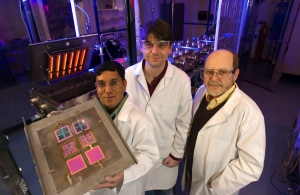Mar 24 2008
The University of Delaware's Institute of Energy Conversion (IEC) will receive $3.75 million from the U.S. Department of Energy's Solar America Initiative over the next three years to continue leading-edge research on photovoltaic-based solar cells.
 From left, Ujjwal Das, research associate, Stuart Bowden, associate scientist, and Robert Birkmire, professor and director of UD's Institute of Energy Conversion, display high-efficiency silicon solar cells created in the plasma-enhanced chemical vapor deposition chamber behind them.
From left, Ujjwal Das, research associate, Stuart Bowden, associate scientist, and Robert Birkmire, professor and director of UD's Institute of Energy Conversion, display high-efficiency silicon solar cells created in the plasma-enhanced chemical vapor deposition chamber behind them.
Of the nine universities selected by DOE to receive the competitive funding, which is matched in part by industry collaborators, UD is the largest grant recipient and one of only two universities to be awarded two research projects, which will be conducted in collaboration with Dow Corning Corp. and SunPower Corp., respectively.
UD now leads the nation's universities in competitive funding received from DOE's Solar America Initiative, which is designed to accelerate the development of advanced solar energy technologies.
The latest two grants follow on the heels of UD's $1.2 million award in November from the Solar America Initiative's Future Generation Photovoltaic Devices and Processes program to develop advanced thin film-tandem junction solar cells. UD also is a subcontractor on four industry-led Solar America Initiative programs awarded to Dow Chemical, GE, Konarka and SoloPower.
The Solar America Initiative, part of President George W. Bush's Advanced Energy Initiative, seeks to make solar energy cost-competitive with conventional forms of electricity by 2015 through complementary activities in the research and development of solar technologies to reduce costs, and in marketplace transformation to eliminate barriers to commercialization.
“The Solar America Initiative is an exciting program that will enable us to continue our research in established areas, as well as develop expertise in new facets of photovoltaics working with our industry partners,” said Robert Birkmire, professor of materials science and engineering and director of IEC.
Photovoltaic-based solar cells convert sunlight directly into electricity and are made of semiconductor materials similar to those used in computer chips. When sunlight is absorbed by these materials, the solar energy knocks electrons loose from the atoms, allowing the electrons to flow through the material to produce electricity.
With Dow Corning Corp., researchers at IEC will expand their pioneering research on flexible, copper-indium-gallium-diselenide (CIGS) solar cells, which are created by depositing a semiconductor material composed of copper, indium, gallium, and selenium onto a thin, film-like substrate.
Last year, IEC scientists reported on advancements in a new roll-to-roll technology for manufacturing flexible CIGS solar cells in long sheets, much like newsprint from a printing press, which opens the door to the manufacture of lightweight solar panels for roofs, spacecraft and many other applications.
Now, scientists at IEC will be working to develop a low-cost, silicon-coated, stainless steel substrate capable of withstanding the high processing temperatures required to produce high-quality CIGS films using a variety of roll-to-roll manufacturing techniques. The target is to produce solar cells with efficiencies greater than 12 percent, which means that a module can convert 12 percent of the incoming sunlight into electricity. For a typical solar module with an area of 1 square meter (about 10 square feet), this represents the generation of 120 watts of electricity.
In collaboration with SunPower Corp., a Silicon Valley-based manufacturer of the highest efficiency crystalline silicon solar cells, panels and systems, IEC researchers will couple amorphous silicon (a-Si) films with crystalline silicon wafers to enable low-temperature processing and enhance electrical performance of crystalline silicon solar cells. The goal is to increase conversion efficiencies beyond 26 percent. Amorphous silicon films typically are used in liquid-crystal displays (LCDs), as well as for solar modules.
Established at UD in 1972, IEC works collaboratively with universities and companies around the world in the development of thin-film photovoltaics. It was designated a University Center of Excellence for Photovoltaic Research and Education by the Department of Energy and the National Renewable Energy Laboratory in 1992.
In recent years, IEC researchers have developed 10 new technologies, eight of which already have been issued as patents, relating to the fabrication of photovoltaic devices. So far, 60 percent of these solar innovations have been licensed--all to companies in the United States.
Additionally, the broad scope of IEC's research and development effort offers undergraduate and graduate students, postdoctoral fellows and visiting scholars unique educational opportunities in the fields of physics, chemistry, materials science, chemical engineering, mechanical engineering and electrical engineering, as well as collaboration with industrial groups seeking to manufacture and commercialize photovoltaics.
“We've developed a great group of people here--an integrated team of scientists and students from different disciplines, which is critical to this research,” Birkmire noted.